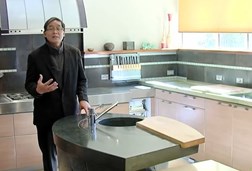- Concrete Homes Home
- Concrete Homes Pictures
- Do Concrete Homes Cost More?
- Optimizing the Energy Efficiency of an ICF Home
- Design Ideas for Concrete Homes
- Related Information
- Hurricane-Proof Homes
- Building Concrete Safe Rooms
- Going Green with Concrete: An Overview of Concrete's Eco-Friendly Benefits
- Tilt-Up Concrete Construction
- Building a Concrete Basement
- Other Resources
- Concrete Home Infographic
- Free Brochures
- Concrete Contractors: Find Concrete Form Products and Suppliers
Section Sponsor

Concrete Homes
Concrete Countertops & Kitchen Design
Kitchen Design and Concrete Countertops
Time: 05:36
Welcome to the House 6 kitchen, and I actually got my start in kitchens so kitchen design is really an integral part of a house for me. It's a very important aspect of a house. I do believe that starting out and designing a lot of kitchens in the early part of my career came out of a very good reason. I like to cook and I was working on my own house, which I still live in today, and that's where the first concrete countertop was made back in the early 80s, and where I began to experiment with the idea of using sculptural material like concrete in a very practical way.
With kitchen design, there's a lot of intensity that's involved. There's a lot of thought that takes place. There's a lot of activity that needs to happen, and that challenges you as a designer to separate yourself from convention, when everybody is assuming that the paradigm of a kitchen is a box with a slab of something material on top, and it's all a bologna and cheese kind of design. Here, with the element of adding something sculptural that is both practical and compelling, emotionally touching, feeling, that's where you really begin to be able to stretch ideas, and this kitchen is no exception.
Concrete countertops and islandWe have a center island here, which is both a gathering place and a dining area in the kitchen, with a working counter here and a sink. And this is made out of concrete, of course. It adds a kind of sculptural element into what would normally be just an ordinary rectilinear island. On the left over here, you see that this is one long concrete countertop, and it has a sliding cutting board. These are sort of the usual features that I've been doing for the last 30 years making concrete countertops, but in this case, creating this sense of light with this long band of windows, not using as many upper cabinets, trying to push most of the storage elements onto one wall so that it frees up the other walls for a more open feel.
This particular concrete countertop, which is in our celadon green color, was made in our shop. I usually like to use something like this, a long element, and where you have a drain board and things like that, it gives it a sculptural quality. That's the reason to use concrete. For instance, this island, same thing. This is in our charcoal color Pro Formula. I call this "Nemo," because it has this sort of nautilus kind of shape, but with these textural changes and things like this, that's what gives concrete its raison d'etre. You can't do this with other materials. You can't do this with granite and manufactured stone. I try not to use concrete everywhere because there are some drawbacks to concrete, as we know. There are issues about cracking, staining, things like that, which can be overcome by using it in the right places. And the right places in this kitchen, to me, mean the sculptural island and the sink area. Around the stove where you have a high intense use of different oils and sauces and things like that, I prefer to use something like stainless steel. So it's just this complement of practical reason for the complementary materials here.
Bamboo adds warmthNot only do we have the Japanese plaster, but we've used an element of whimsy here with these bamboo three-form panels that open up to reveal a pantry. The bamboo floor is here to warm up the kitchen, not to have a continuation of the concrete floors in here. It was very important to create this nice ambiance surrounded by warm materials, wood cabinets, Japanese plaster, very tactile. And then the concrete now can be here on an island, for instance, instead of the floor.
It wasn't until six months later that I knew if the floor came out or not. But, in this case, it came out really well. It almost looks like a terrazzo floor, completely terrazzo, which is poured at about 5/8 inch thick and it's all very controlled. Well, this is on an 18-inch slab of concrete the day of the pour, so it's a very different experience. You don't have as much control. On the other hand, being not so controlled, gives it an element or an organic quality that you don't get with terrazzo, which can tend to look really commercial because everything is regulated with terrazzo. They regulate the exact size of the aggregate, how much you broadcast, and with those exacting proportions, they can replicate those everywhere, in airports and things like that.
From countertops to floors, fireplaces, walls, you can see that anything is possible with concrete. You can start small and dream big.





